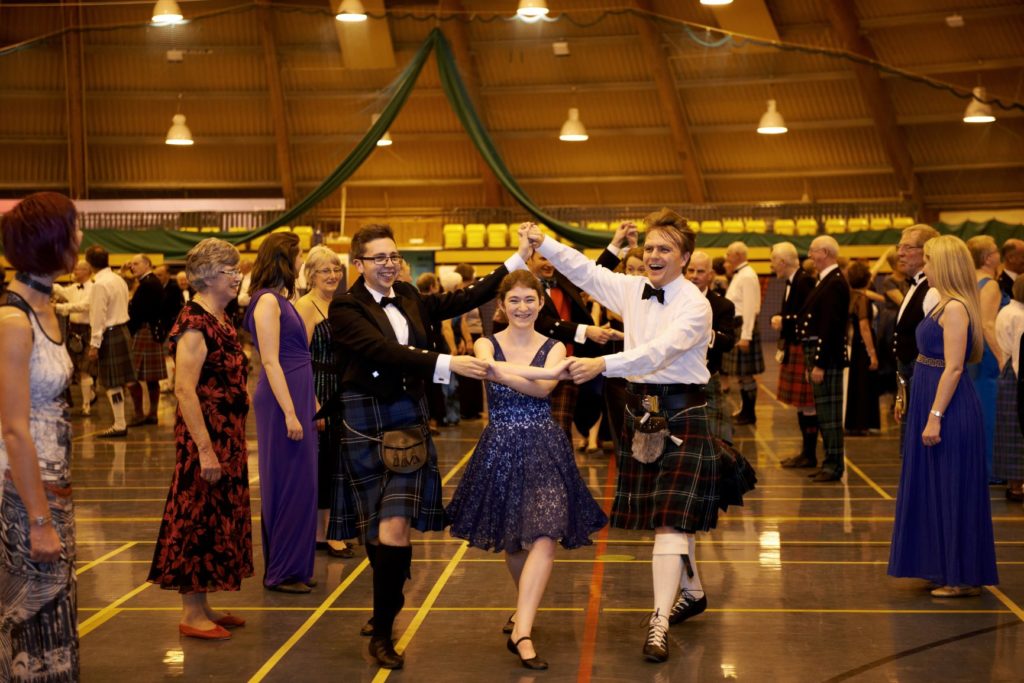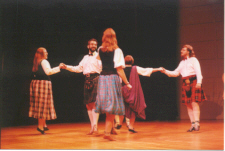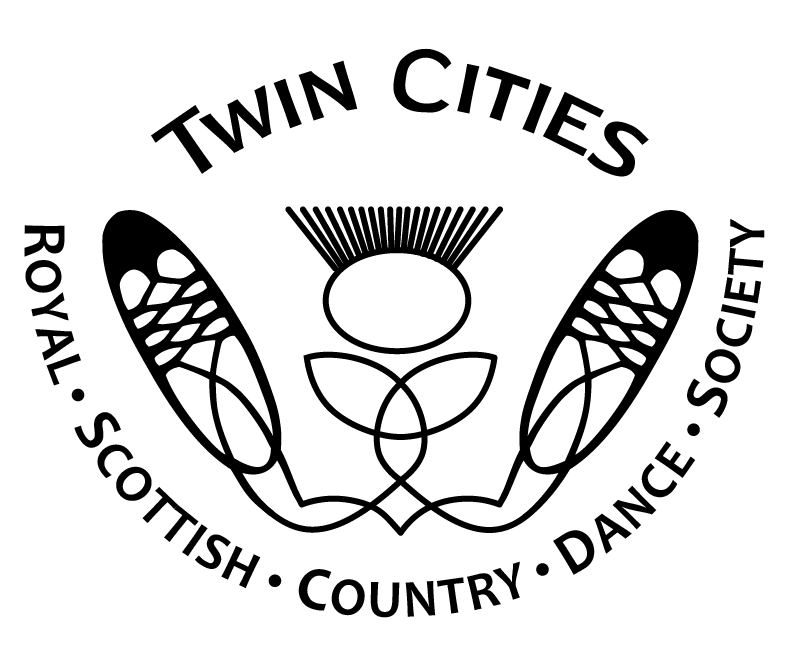The Short Answer:

- Social dancing style first popular in Scotland during the 18th century and then revived by the Royal Scottish Country Dance Society during the 1920s.
- Considered the traditional “ballroom dancing” of Scotland.
- Done with a partner (a different person for each dance, typically) in “sets” of 3 to 5 couples
- Consists of a series of patterns that you, your partner, and the other dancers in your set make on the floor, usually causing each couple to rotate to a different position. The series of patterns is then repeated until each couple has danced from every position.
- Danced to jigs and reels and strathspeys using specialized steps that involve a lot of skipping, hopping, and toe pointing
- NOT highland dancing
The Long Answer:
Scottish country dancing is a modern form of the “country dancing” popular in England and Scotland in the 18th century. It involves groups of six to ten people (most of the time) of mixed gender (most of the time) — a “set” — dancing to the driving strains of reels, jigs and strathspeys played on the fiddle, accordion, flute, piano, drums, etc. (no bagpipes, mostly!). The dance often combines solo figures for the “first couple” in the set with movements for all the dancers, although there is considerable variation — there are over 9000 different dances cataloged, of which maybe 1000 or so are of lasting and non-local importance. Many of these dances derive from traditional sources such as old manuscripts and printed dance collections, but a lot have been devised in the past fifty years or so. This fusion of the traditional and the modern as well as its ongoing evolution are part of the attraction of Scottish country dancing.
Scottish country dancing is characterized by:
- Structure – dances follow certain kinds of patterns and conventions
- Sociability – you dance with a partner and interact with that person as well as others in your set of 3 to 5 couples throughout the dance
- Energy – the steps involve quite a bit of skipping and hopping
- Technique – there is a lot of terminology and other influence from ballet (think turnout and pointed toes) and a lot of emphasis on footwork, handing, and phrasing
SCD is related to and shares many similarities with other forms of social dance originating in the UK and North America but is distinct.
- The structure and formations are similar to English country dancing, contra dancing, and American square dancing, but the music is different and the footwork much more vigorous and detailed.
- SCD includes many of the same dances as Scottish ceilidh dancing but has a much bigger repertoire and focuses mainly on “set” dances rather than dances done as just a couple. There is also more emphasis on technique.
- SCD is similar to Scottish “reeling” but places more emphasis on technique, especially footwork.
There are a couple dozen basic figures which will get you through quite a number of dances, although many dances have their own quirks and special features which make them unique and fun to do. The basic technique can be learned at a weekend workshop or through a couple of months’ worth of practice evenings once a week, but may take much longer to really master. Most SCD groups offer weekly classes to teach the technique and formations and will host several informal social dances a year and at least one formal ball. A variety of dances may be done in a typical weekly class, but there is generally no expectation that you memorize them. The the programs for balls and social evenings are usually published well before the event, so everybody can check their crib sheets. Also, at the event itself dances are typically recapitulated or even sometimes walked through slowly before the music starts (although local custom may vary).

SCD is a very social form of dancing, not only because you get to dance with seven or so people at once instead of just with one partner (smiles and eye contact are encouraged, and if you want there is a lot of opportunity for relaxed “flirting”) but also because there are workshops, balls and social dances being held in places all over the world. It is nice to be able to travel and join a SCD group for a night nearly anywhere you go.
Historical Origins
When country dancing came to Scotland in the 18th century, it was at first popular among the townspeople in places like Edinburgh, but spread throughout Scotland (at varying pace) and thrived there even when, during the 19th and early 20th century, more modern dances like the waltz, one-step etc. became fashionable in other places. Country dancing in Scotland was also influenced by other Scottish dances such as highland reels and so acquired a particular “Scottish” flavor.
In 1923, the Scottish Country Dance Society (SCDS, later “Royal” Scottish Country Dance Society or RSCDS) was founded in order to preserve traditional Scottish country dancing. Its patrons went out to watch people dance and collect the dances for publication. In the process, they also tried to reconstruct and publish dances from old manuscripts that were no longer actually danced, and standardized technical points like steps and footwork (which the common folk rarely bothered a lot about). It is debatable whether this standardization was actually a good thing as far as preserving the tradition of Scottish country dancing was concerned, but it has certainly done a lot for making SCD into something that can be enjoyed internationally. In fact, Scottish country dancing is probably more alive today than it ever was in the past, and this is to a large extent due to the efforts of the RSCDS.
Today the RSCDS numbers about 12,000 members and has “branches” (also called “local associations”) in various countries all over the world. Lots of SCD groups are affiliated with the RSCDS even though they aren’t actually branches of the Society, and even more people enjoy SCD without being members of the RSCDS (or any group) at all.
Based on text originally written by Anselm Lingnau for the soc.culture.scottish FAQ and posted on the Strathspey Web site
